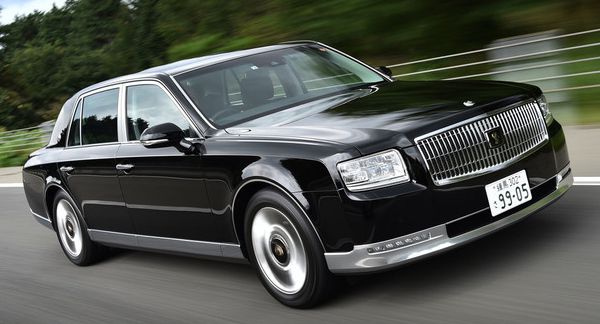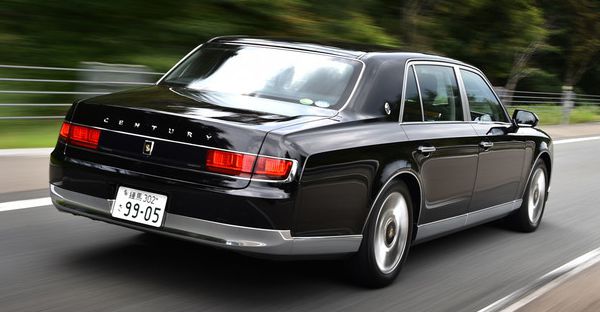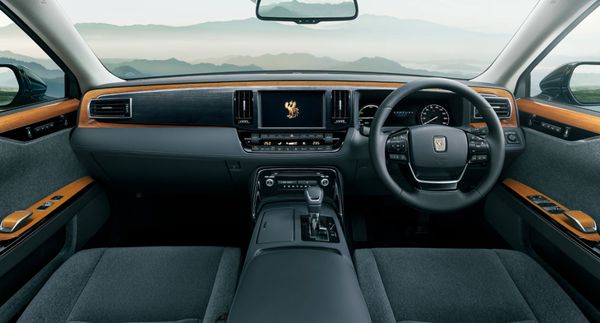Published
on 1
Oct 2021
|
All rights reserved.
|
|
|

|
|
Whether
like it or not, you will spend the next 20 years looking at the same
car.
|
|
This
is deemed to be the best car built by Japanese motor industry. It rides
on the latest TNGA platform, powered by hydrogen, driven and steered by
4 wheels, capable of Level 3 autonomous driving, has the latest
infotainment system with “Hey Century” voice control, trimmed with 100%
recycled materials, and its software is updated over the air every 20
days…
Of course not! On the contrary, Toyota Century is the world’s most
conservative vehicle, so conservative that it makes Rolls-Royce look
avant-garde! Progress is meaningless to this car, whose 1st generation
lasted 30 years (1967-97), followed by another 20 years (1997-2017)
spent in the 2nd generation. The current generation was introduced in
2018, expect it will serve until internal combustion engines completely
banned from Japan, if not the end of the world.
Throughout the years, this car has been quite a mystery to Western car
lovers. They know it is the choice of the Japanese royal family and
politicians, although there is pretty much no choice since the demise
of Nissan President and Mitsubishi Dignity.
However, the Century is no stranger to Hongkongers, because our first
chief executive chose this car as his official transport. It goes
without saying the choice of car reflects one’s taste and character.
Having seen Century many times on street – no matter Mk1 or Mk2 – I
have to admit that it has quite a road presence, chiefly because no
other running cars look this huge and boxy anymore. The Mk3 is no
exception. Its long and boxy shape dates back to American luxury cars
in the 1950s, something, interestingly, still influences the president
cars in Russia and China. I won’t use “timeless” to describe it,
because it does look outdated now – maybe 40 years ago even. However,
emperors and successful businessmen need symbols to emphasize
their unusual ranks. What can be better than an unusual car that nobody
else buys?

|
|
Rides
superbly on smooth roads, less impressive on poorer ones.
|
|
Therefore, the Century is meant to be rare. Toyota aims to build only
600 cars a year, versus 5,000 Rolls-Royces and 10,000 Bentleys built
every year. Price starts from 20 million yen, or about USD180,000,
which slips between an S-class and Bentley. For such a low production
volume, automation is inevitably ruled out. The Century is built
largely by hands in the Higashi-Fuji plant. The body panels are
hand-fitted and aligned by craftsmen, as is the paint job, which
requires 4 very experienced craftsmen to apply 7 layers of paint and
coating and sand-polished by hand after every layer. The result is a
mirror-finish that makes Toyota very proud of. Unfortunately, there are
only 4 colors to choose from, and almost all customers choose black.
The Century is huge. Maybe not as huge as Rolls-Royce, but still a
5335mm long, 1930mm wide and 1505mm tall body is huge for Japanese
streets. The same goes for its 2370 kg kerb weight, which is an
increase of 380kg over its predecessor. Weight saving and drag
coefficient are irrelevant to its customers.
While the old car was famous for running Japan’s only V12 motor, the
latest car has changed to a hybrid V8. Toyota said its target customers
are usually company CEOs and chairmen, so a greener hybrid V8 are
important to
their company images. However, I think the change is more to do with
development costs, as it makes little sense to update the V12 to meet
emission requirements and higher power demand for only 600 cars a year.
In fact, the underpinnings of the new car as well as the entire
powertrain come from the last generation Lexus LS600h. That makes it a
full generation behind the Lexus, but using a hybrid V8 still sounds
more graceful than a V6 turbo or V6 hybrid, doesn’t it? This powertrain
offers a combined output of 391 horsepower, 200 short of Rolls-Royce.
Calibrated to deliver a
relaxing throttle and transmission response, expect 0-60 mph will take
well over 6 seconds.

|
|
Almost
100 percent buyers will not spend time here.
|
|
The Century is a chauffeur car, more so than Rolls-Royce, as nearly 100
percent buyers ride at the back seat. If you are the chauffeur, you
will find a driving experience even more old-school than Rolls-Royce.
Its air suspension is tuned very soft, as are the tall side wall of the
special Bridgestone tires. It rides smoothly and quietly on normal
Japanese roads, which are usually well paved. However, riding over big
bumps or ridges, the suspension will bounce heavily, the long-wheelbase
chassis vibrates and amplifies the noise in the cabin, which means it
lacks the sophisticated damping and chassis rigidity of modern luxury
limousines.
All controls are tuned to be light and soft in response. Step on the
gas pedal
quickly, the engine and transmission seem to have their own agenda,
picking up speed linearly without discomforting the boss. Ditto the
braking. The steering is light, slow and almost lifeless, but a
chauffeur won’t mind. Push the big car more urgently into a corner, it
will lean
gradually but ultimately heavily on the outside wheels, accompanied
with plenty of understeer to call your back off. This car has only one
mission: take you to the destination as smoothly and safely as
possible. Any talk of handling or driving pleasure is nonsense to the
back seat boss.
At full acceleration, the planetary CVT tends to rev the V8 hard thus
you can hear some engine noise in the cabin. Otherwise, when the car
settles in a cruise, the cabin is as quiet as a concert hall, thanks to
double-glazing windows, thick sound absorbing foams, active noise
cancellation system and silent tires. Also like in a concert hall, you
sit at the back at a slightly elevated position, have a commanding view
over the chauffeur and the road ahead.

|
|
Equipment,
ergonomics and quality fall short of European standards.
|
|
The cabin is huge, of course. It is supposed to demonstrate the finest
craftsmanship of Japan. One example is the hand-crafted Japanese-style
wood inserts, which contrasts the walnut used in its European
counterparts. Whether it shows higher quality, I don’t know, but it is
different. The same goes for using wool fabric as upholstery (though
you can opt for leather). The Japanese reckons wool classier than
leather, although the latter is easier to clean. The problem is,
lacquered walnut and leather look more expensive to our eyes, and the
color options, the stitching, the brushed aluminum and detailed
finishing you will find in Rolls-Royce or Bentley or even Maybach are
just too high a standard for the Toyota to match.
The same goes for back seat comfort. While the Century’s left rear seat
is super soft and comfy, it is not quite as versatile as the airliner
seats of its rivals. It can recline, and the front passenger seat can
slide forward and reveal a leg support at a touch of button, but still
the legroom is too short for six-footers to stretch their legs (older
Japanese businessmen would be fine). While the left rear seat offers
heating and massaging, it has no cooling, and the massaging is a bit
weak. And why doesn’t another rear seat offer these creature comforts?
Why is there no refrigerator for a glass of beer or champagne? Why is
the infotainment screen stands in the middle of the transmission tunnel
rather than directly in front of each rear seat? Why are the windows
offer conventional curtains instead of electric sun shades? Why is
there no panoramic glass roof option? And modern LED ambient lighting?
The basic architecture of this cabin is very old school, not designed
according to ergonomics and the latest technology. It reflects the
limitation of an ultra-low volume product.
Yet the back seat is already much better than the front. The analogue
instrument looks like coming from 1990s. Many switchgears feel
plasticky, not worth a place in such a classy limousine. Lacking a
360-degree camera makes the large car difficult to park in tight space.
Similarly, it doesn’t get the latest adaptive cruise control with lane
keeping, which you can find in even Toyota’s compact cars. European
luxury car makers won’t overlook these details.
More upset is, you will spend the next 20 years looking at the same
car.
|
Verdict:  
|
|